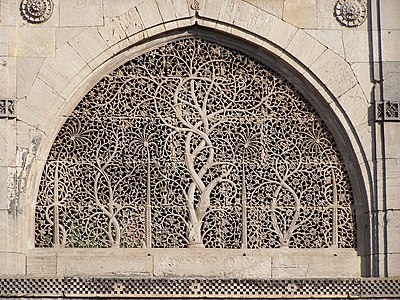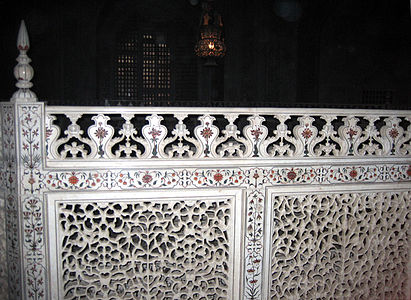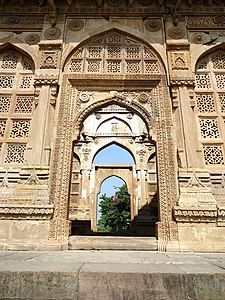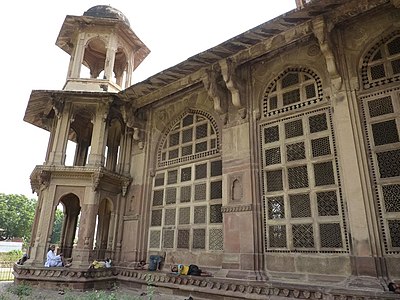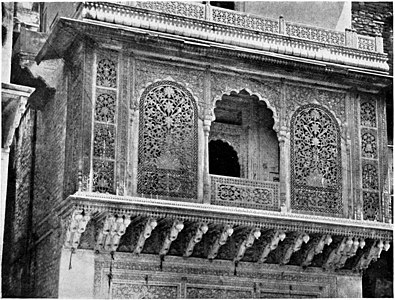Jali



A jali or jaali (jālī, meaning "net") is the term for a perforated stone or
According to Yatin Pandya, the jali allows light and air in while minimizing the sun and the rain, as well as providing cooling through passive ventilation.[3] The holes are nearly the same width or smaller than the thickness of the stone, thus providing structural strength. It has been observed that humid areas like Kerala and Konkan have larger holes with overall lower opacity than compared with the dry climate regions of Gujarat and Rajasthan.[3]

With the widespread use of glass in the late 19th century, and compactness of the residential areas in modern India, jalis became less frequent for privacy and security matters.
History
The earliest
Early jali work with multiple geometric shapes was built by carving into stone, in
]In the
Museum collections
Some of the jalis are in major museums in the U.S. and Europe. These include the Indianapolis Museum of Art,[10] the Metropolitan Museum of Art[11] and the Victoria and Albert Museum.[12]
Illustrations
-
Window at Alai Darwaza, Qutb complex
-
Jali inSidi Saiyyed mosque in Ahmedabad, exhibiting the traditional Indian tree of life motif
-
Jali at Tomb of Salim Chishti in Fatehpur Sikri, showing Islamic geometric patterns developed in Western Asia
-
Jali atAurangabad, with typical Indian motifs
-
Jali at Champaner, utilizing traditional Indian geometric patterns and Islamic geometry
-
Jalis in Mohammad Gaus Tomb in Gwalior
-
19th-century house in Gwalior, using stone jalis
See also
References
- ^ a b Lerner 1984, pp. 156–157.
- ^ a b Azmi, Feza Tabassum (20 September 2022). "How India's lattice buildings cool without air con". www.bbc.com.
- ^ a b Pandya, Yatin (16 October 2011). "Yatin Pandya on 'jaali' as a traditional element". DNA India. Retrieved 1 October 2022.
- ^ Satyaprakash Varanashi (30 January 2011). "The multi-functional jaali". The Hindu. Retrieved 18 January 2016.
- ^ "Jali by Mapin Publishing - Issuu". issuu.com. 2 November 2021. Retrieved 6 August 2023.
- ^ Jali: Lattice of Divine Light, with Navina Najat Haidar, retrieved 6 August 2023
- ISBN 9781462906420.
- ^ Hariharnivas Dvidedi, Gwalior ke Tomar, 1976, p. 378-380
- ^ Nonperiodic Octagonal Patterns from a Jali Screen in the Mausoleum of Muhammad Ghaus in Gwalior and Their Periodic Relatives, Emil Makovicky & Nicolette M. Makovicky ,Nexus Network Journal volume 19, pages 101–120 (2017)
- ^ JALI PANEL (INDIA), LATE 19TH CENTURY
- ^ Pierced Window Screen (Jali) early 17th century
- ^ Drawing ca.1882 (made)
Sources
- Lerner, Martin (1984). "JALI SCREEN". The Flame and the Lotus: Indian and Southeast Asian Art from the Kronos. New York: Metropolitan Museum of Art. pp. 156–157. OCLC 10799173.
External links
- "ArchNet Dictionary of Islamic Architecture: Jali". archnet.org. 4 June 2003. Archived from the original on 22 December 2004.


